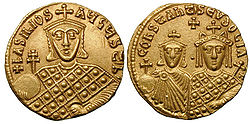Battle of Bathys Ryax
| Battle of Bathys Ryax | |
|---|---|
| Part of the Byzantine–Paulician wars | |
| Result | Byzantine victory |
The Battle of Bathys Ryax was fought in 872 or 878 between the
Background

The Paulicians were a Christian sect whose precise origins and beliefs are somewhat obscure: Byzantine sources portray them as
The Arabs and Paulicians suffered a critical blow in 863 with the defeat and death of Umar at the
Battle

Encouraged by this success, Chrysocheir then staged another deep raid into Anatolia, reaching
When the two generals with their men reached the pass, night had fallen, and the Paulicians, apparently unaware that they were being followed, had made camp in the valley of the pass. The Byzantines took up position in a wooded hill called Zogoloenos that overlooked the Paulician encampment, which further concealed them from their enemy. At this point, the sources record that a dispute broke out between the men of the two thematic corps as to who was the bravest; the two generals decided to take advantage of their troops' high morale and impetuousness to attack, despite their orders.[11][12] A picked detachment of 600 men from both divisions launched a surprise attack at dawn, while the rest of the army remained behind and made loud clamour with trumpets and drums, so as to suggest the imminent arrival of the entire Byzantine field army under Christopher. The ruse worked perfectly: the Paulicians, taken by surprise, panicked and dispersed without offering any serious resistance.[11][12][13] The Paulician rout was completed as they fell upon the main Byzantine army while fleeing. Their remnants were pursued by the victorious Byzantines up to a distance of 50 km. Chrysocheir himself managed to escape with a small detachment of bodyguards, but he was brought at bay at Konstantinou Bounos (probably modern Yildiz Dagı). In the ensuing engagement, he was wounded by Poulades, a Byzantine soldier who had been formerly a captive of the Paulicians, and fell from his horse. He was then captured and beheaded by the advancing Byzantines, and his head was sent to Emperor Basil in Constantinople.[10][11][12]
Aftermath
The defeat at Bathys Ryax signalled the end of the Paulicians as a military power and a threat to Byzantium.[12] Basil followed this success by a series of campaigns in the East against the Paulician strongholds and the Arab emirates. Tephrike itself was taken in 878 and razed to the ground. The remaining Paulicians were resettled in the Balkans, while a large contingent was shipped off to Southern Italy to fight for the Empire under Nikephoros Phokas the Elder.[1][9][14]
Questions of chronology
The chronology and sequence of events regarding the battle and the fall of the Paulician state is unclear, since the Byzantine sources are contradictory: a number of scholars place the battle in 872, others in 878, in both cases either before or after the capture and razing of Tephrike itself by the Byzantines.[1] Thus Alexander Vasiliev proposed a first victorious battle for the Byzantines, followed by the sack of Tephrike and the final Paulician defeat at Bathys Ryax, all in 872. Most recent historians place the battle before the sack of the city, but disagree in the dates of the two events.[1] Some, like Nina Garsoïan[15] or John Haldon,[16] place both events in 878; the French Byzantinist Paul Lemerle, followed by other scholars like Mark Whittow[9] and Warren Treadgold,[17] placed the battle in 872 and the final subjugation of Tephrike years later, in 878 (Treadgold in 879).[1]
References
- ^ a b c d e Kiapidou 2003, Chapter 3.
- ^ a b c Haldon 2001, p. 85.
- ^ ODB, "Paulicians" (N. G. Garsoïan), p. 1606; Jenkins 1987, p. 158.
- ^ Jenkins 1987, pp. 158–159.
- ^ ODB, "Karbeas" (N. G. Garsoïan), p. 1107; "Paulicians" (N. G. Garsoïan), p. 1606.
- ^ a b c d e Kiapidou 2003, Chapter 1 Archived March 5, 2012, at the Wayback Machine.
- ^ Jenkins 1987, pp. 162–163; Whittow 1996, p. 311.
- ^ ODB, "Chrysocheir" (N. G. Garsoïan), pp. 452–453; "Paulicians" (N. G. Garsoïan), p. 1606.
- ^ a b c Whittow 1996, p. 314.
- ^ a b Treadgold 1997, p. 457.
- ^ a b c Kiapidou 2003, Chapter 2.
- ^ a b c d Haldon 2001, p. 87.
- ^ Haldon 1999, pp. 103, 175.
- ^ Jenkins 1987, p. 191.
- ^ Garsoïan 1967, pp. 39, 128.
- ^ Haldon 2001, pp. 85, 87.
- ^ Treadgold 1997, pp. 457–458.
Sources
- Garsoïan, Nina G. (1967). The Paulician Heresy: A Study of the Origin and Development of Paulicianism in Armenia and the Eastern Provinces of the Byzantine Empire. The Hague, The Netherlands: Mouton.
- ISBN 1-85728-495-X.
- Haldon, John (2001). The Byzantine Wars: Battles and Campaigns of the Byzantine Era. Stroud, Gloucestershire: Tempus. ISBN 0-7524-1795-9.
- Jenkins, Romilly (1987). Byzantium: The Imperial Centuries, AD 610–1071. Toronto, Ontario, Canada: University of Toronto Press. ISBN 0-8020-6667-4.
- ISBN 0-19-504652-8.
- Kiapidou, Eirini-Sofia (17 January 2003). "Battle at Bathys Ryax, 872/8". Encyclopedia of the Hellenic World, Asia Minor. Archived from the original on 21 July 2011. Retrieved 25 February 2010.
- ISBN 0-8047-2630-2.
- ISBN 978-0-520-20496-6.
39°50′12″N 36°42′04″E / 39.83667°N 36.70111°E
